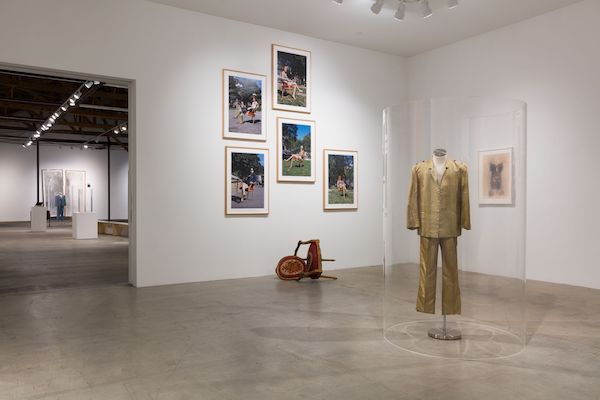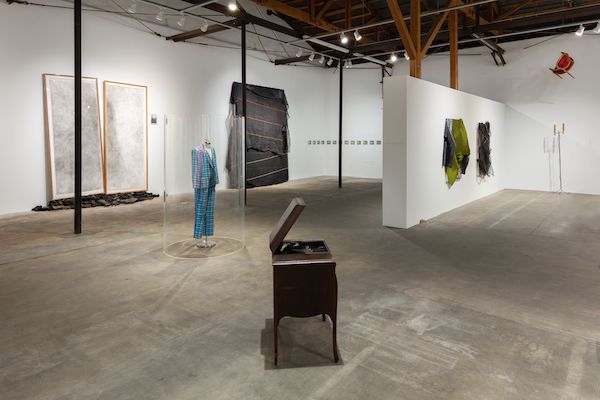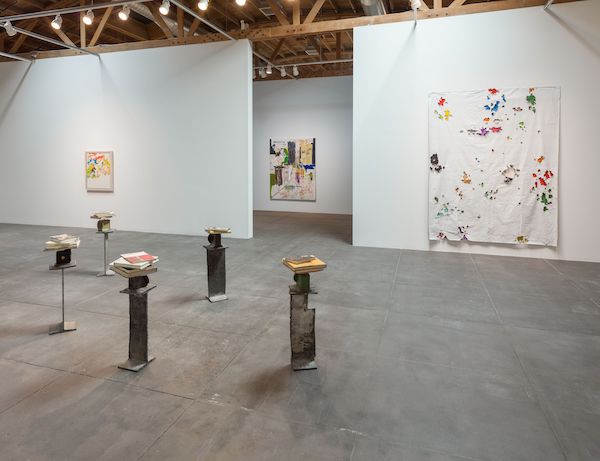David Hammons, an infamously reclusive yet pervasive figure, is undoubtedly a pioneer and solidified staple of the art world. His thought-provoking work permeates the visual language of contemporary art making. From his Duchampian repurposing of found objects, to his visual puns, charged questions and critique of art history’s predominantly white canon, Hammons can seemingly do it all. Perhaps even more importantly, his deep-rooted social and cultural critiques surrounding race, its representation, and its role—not only within art history, but society at large—are ever-present and inescapable.

Installation view, ‘David Hammons’, Hauser & Wirth Los Angeles, 2019
His exhibition at Hauser & Wirth Los Angeles, an almost heroic return for Hammons, who has not shown in LA in 45 years, hits viewers with a barrage of materials, subversions of formal expression, wit and sometimes disparate critiques of wealth, luxury, culture and privilege.
The first installation one experiences is a shrine in the courtyard where “BLACK LIVES MATTER” is engraved into a stone surrounded by flower bouquets and prayer candles. Behind and all around this, seemingly new camping tents are scattered densely throughout the space.

Installation view, ‘David Hammons’, Hauser & Wirth Los Angeles, 2019
The faux tent city, presented in the heart of DTLA’s Arts District, sets an initial tone of disconnect, inducing an unsettling and provocative note of irony (especially given the artist’s ambiguity) as a visual marker of Los Angeles’ homeless epidemic, which pervades neighborhoods in the immediate vicinity and throughout Los Angeles. A gallery director shared that one reason Hammons agreed to this venue—having turned down many institutional shows—is that it’s not a museum that charges admission, theoretically creating a more open environment for people of varying socioeconomic backgrounds. While the gallery doesn’t charge admission, their clientele is largely made up of wealthy collectors and affluent influencers, leaving the viewer to wrestle with the stark contrasts that exist within our cities and are embedded in our social fabric.

Installation view, ‘David Hammons’, Hauser & Wirth Los Angeles, 2019
Hammons’ installation pricks at his audience—“This could be u” tidily stenciled onto the side of a tent—and simultaneously reflects on the artist’s role in society. What power does art have to effect change, other than to critique? And what are we to make of the intrinsic link between wealth and power with privileged positions in the art world, beyond noting our critical discomfort?
In another installation, of burnt and painted fur coats standing before a towering mirror that has been covered with sheets of metal, Hammons appears to question this very dynamic. His art-historical references feel so contemporary and relevant—his nods to Duchamp, De Kooning, Basquiat, Dada and Arte Povera—the list goes on. An arrangement of antique scales bearing the weight of Hammons’ own library of art historical books (Untitled, 2018) is a slightly obvious, yet strong metaphor for the weight of art history under which he creates.

Installation view, ‘David Hammons’, Hauser & Wirth Los Angeles, 2019
His covered paintings reveal glimpses of expressive color, looming over viewers with an air of mystery. One piece reveals vivid color behind brown paper wrapping that has been torn open like a package. Another, one of the largest of these paintings is veiled with a translucent black fabric reminiscent of Rothko’s darker palettes. Here, he manages to recontextualize American AbEx (infamous for its domination by white men) while also giving us paintings that are as beautifully powerful as ever. Perhaps one of Hammons’ most substantial points is that everything about this exhibition space speaks to social and economic privilege and his work introduces an incursion: a tent city imposing on a posh brunch (consider how this could be u) or hair swept up from a barbershop floor to be laid upon a lush chaise lounge. In typical Hammons style, his intention remains unclear—what amounts to a press release is a line drawing that refers to Jazz musician Ornette Coleman—and the viewer is left to infer his position.
Photos by Fredrik Nilsen Studio.



















0 Comments